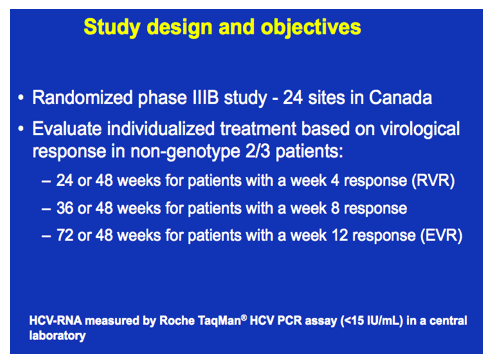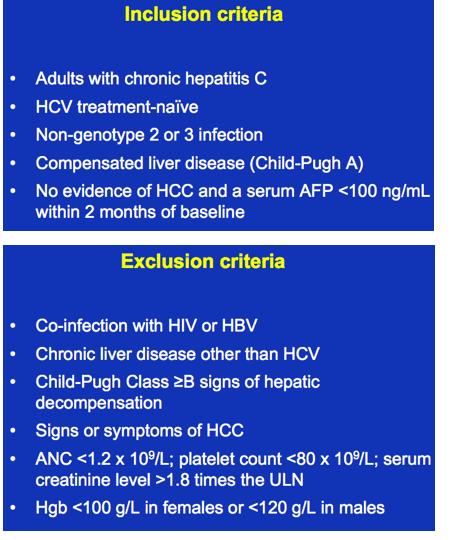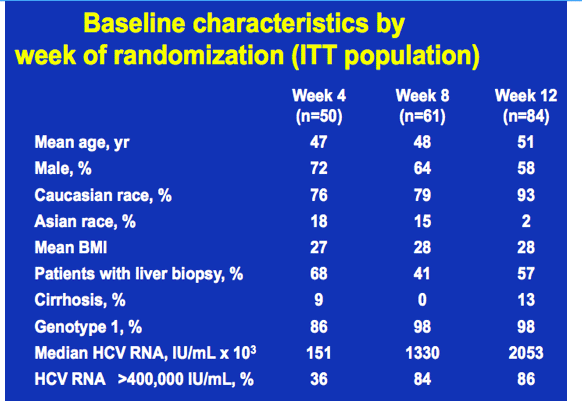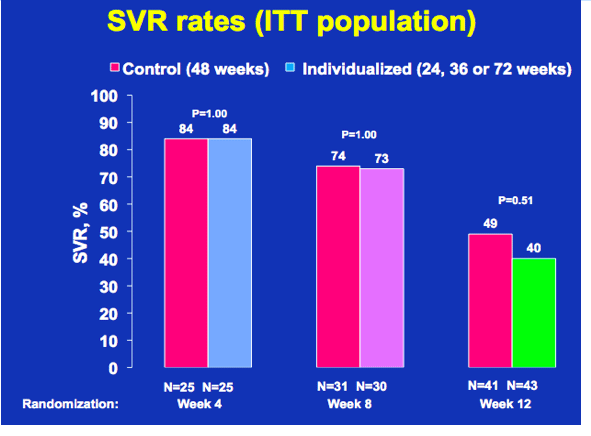 |
 |
 |
| |
36 versus 48 weeks of treatment with peginterferon alfa-2a plus ribavirin for genotype 1/4 patients with undetectable HCV RNA at week 8: Final results of a randomized multicenter study
|
| |
| |
Reported by Jules Levin
SS Lee,1 M Sherman,2 A Ramji,3 S Greenbloom,4 M El-Kashab,5 H Pluta,6 N Hilzenrat,7 R Balshaw,8 C Usaty,9 RP Myers1
1University of Calgary, Calgary; 2University Health Network, Toronto; 3UBC, Vancouver; 4Toronto Digestive Disease Associates, Toronto; 5Toronto Liver Centre, Toronto; 6Gastroenterology and Hepatology Clinic, Abbotsford; 7Montreal Jewish General Hospital, Montreal;
8Syreon Corporation, Vancouver; 9Roche, Mississauga
ABSTRACT
METHODS:
Treatment-naïve adults with HCV genotype 1/4 infection initiated treatment with PegIFNα2a 180 µg/week plus RBV 1000/1200/1400 mg/day (bodyweight <75/≥75/≥85 kg) and were randomized to individualized treatment durations on the basis of their HCV RNA status at week 4, 8 or 12. Those who were HCV RNA negative (Roche Taqman Limit of detection 15 IU/mL) at week 4 (RVR) were randomized to 24 or 48 weeks of treatment; those who were negative at week 8 were randomized to 36 or 48 weeks and those with an EVR (negative or ≥2-log drop) at week 12 were randomized to 48 or 72 weeks of treatment. Sustained virological response (SVR) was defined as undetectable HCV RNA after 24 weeks of untreated follow-up.
RESULTS:
A total of 236 patients started treatment and 195 were randomized at week 4 (n=50), 8 (n=61) or 12 (n=84) and included in the ITT population. Patient groups randomized at week 4, 8 and 12 were well matched. SVR rates were highest in patients randomized at week 4 (42/50, 84%) and week 8 (45/61, 74%) and lowest in those randomized at week 12 (37/84, 44%). SVR rates were similar in patients randomized to 24 or 48 weeks of treatment at week 4 (84% and 84%, respectively), those randomized to either 36 or 48 weeks at week 8 (73% and 74%, respectively) and those randomized to 48 or 72 weeks at week 12 (49% versus 40%, p=NS). Rates of premature withdrawal were highest in patients randomized at week 12. The overall SVR rates were similar in patients randomized to individualized treatment durations (60/98, 61%) and the standard 48-week duration (64/97, 66%).
CONCLUSION:
The most novel finding of this prospective randomized multicenter trial is that a 36 week treatment duration provides similar SVR rates to a standard 48-week treatment duration in genotype 1/4 patients who become HCV RNA negative between week 4 and 8 of treatment with PegIFNα2a plus RBV. Such patients may be considered for a shorter 36-week treatment duration.




|
| |
|
 |
 |
|
|